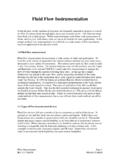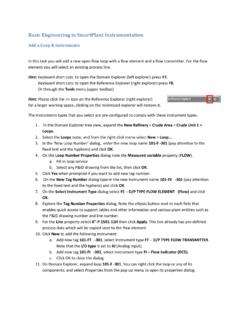Transcription of INSTRUMENTATION AND CONTROL TUTORIAL 1 - …
1 1 instrumentation and control tutorial 1 CREATING MODELS OF ENGINEERING SYSTEMS This TUTORIAL is of interest to any student studying CONTROL systems and in particular the EC module D227 CONTROL System Engineering. The purpose of this TUTORIAL is to introduce students to the basic elements of engineering systems and how to create a transfer function for them. The TUTORIAL is mainly informative and consists of examples showing the derivation of models for real hardware systems.
2 The self assessment material is based on basic general engineering knowledge. On completion of this TUTORIAL , you should be able to do the following. Derive the mathematical models of basic mechanical systems. Derive the mathematical models of basic fluid power systems. Derive the mathematical models of basic thermal systems. Derive the mathematical models of basic electrical systems. Recognise the similarity between models of different systems. Explain the standard first and second order transfer functions.
3 Explain the link between open and closed loop transfer functions. If you are not familiar with INSTRUMENTATION used in CONTROL engineering, you should complete the tutorials on INSTRUMENTATION Systems. In order to complete this TUTORIAL , you must be familiar with basic mechanical and electrical science. You should also be familiar with the Laplace transform and a TUTORIAL on this may be found in the maths section. You can also find tutorials on fluid power on this site. TUTORIAL 2 in this series gives a detailed account of electric motor models and you may wish to study this first.
4 2 1. INTRODUCTION Engineering systems is a very broad area ranging from CONTROL of a power station to CONTROL of a motor s speed. The student needs to have a broad base knowledge of engineering science in order to understand the various elements and see how many of them are mathematically the same (analogues of each other). Different kinds of engineering systems often conform to similar laws and there are clear analogies between electrical, mechanical, thermal and fluid systems. The basic laws which we use most often concern Resistance R, Capacitance C, Inductance L and conservation laws.
5 You do not need to study all these in detail and the appropriate law will be explained as required. Here is a table showing the main analogue components. It is useful to note that capacitance is a zero order differential equation, resistance is a first order differential equation and Inductance/inertia/inertance is a second order differential equation. MECHANICAL ELECTRICAL THERMAL FLUID Spring x = C F = (1/k) F Electrical Capacitor Q = C V Thermal capacitor Q = C T Fluid Capacitor M = C x p Damper Force = kd x velocity F = kd dx/dt Torque = kd x Ohm's Law V = R I V = R dQ/dt Heat Transfer Laws T = R T = R dQ/dt Fluid friction Laws do not conform to this pattern.
6 Newton's 2nd Law of motion Force = Mass x acceleration F = M d2x/dt2 Law of Inductors V = L d2q/dt2 No equivalence Fluid inertance p = Ld2v/dt2 D'Alembert's Principles Force = 0 Moment = 0 Kirchoff's Laws current = 0 Law of Conservation of Energy Energy = constant Law of Conservation of Mass Mass = constant Let s look at the similarity of the various quantities used in these systems. 2. SIMILARITY OF ELEMENTS CAPACITANCE The symbol C will be used for electrical, thermal and fluid capacitance.
7 Mechanical capacitance is equivalent to 1/k for mechanical systems where k is the spring stiffness. RESISTANCE The symbol R will be used for electrical and thermal resistance. Mechanical/hydraulic resistance is called the damping coefficient and has various symbols. INDUCTANCE / INERTIA / INERTANCE The symbol L will be used for electrical inductance and fluid inertance. In mechanical systems, mass M is the equivalent property for linear motion and moment of inertia I for angular motion. OTHER EQUIVALENT PROPERTIES Q is the symbol for electric charge and quantity of heat.
8 This is equivalent to displacement in mechanical systems, these being distance (usually x) or angle (usually ). V is the symbol for electric voltage (potential difference or ) and is equivalent to temperature T for thermal systems, Force F for mechanical systems and pressure p for fluid systems. v or u is the symbol for velocity in mechanical systems and this is equivalent to electric current (I or i) and heat flow rate . 3 LAPLACE TRANSFORM and TRANSFER FUNCTIONS Laplace is covered in detail in later tutorials and in the maths section.
9 The purpose of this transform is to allow differential equations to be converted into a normal algebraic equation in which the quantity s is just a normal algebraic quantity. In this TUTORIAL we should simply regard it as a shorthand method of writing differential coefficients such that: s becomesdt d s becomesdt d s becomesdtd nnn222 4 TRANSFER FUNCTIONS The models of systems are often written in the form of a ratio of Output/Input. If the models are turned into a function of s it is called a transfer function and this is usually denoted as G(s).
10 InputOutputG(s)= The output and input are functions of s. Now let s examine the mathematical models of some mechanical systems. 3 5. BASIC MODELS OF MECHANICAL SYSTEMS GENERAL PROCEDURE The general procedure for mechanical systems is as follows. i. Adopt a suitable co-ordinate system with an appropriate sign convention. For linear motion, up is positive and left to right is positive. For rotation anticlockwise is positive and clockwise is negative. These may be ignored when convenient.
















